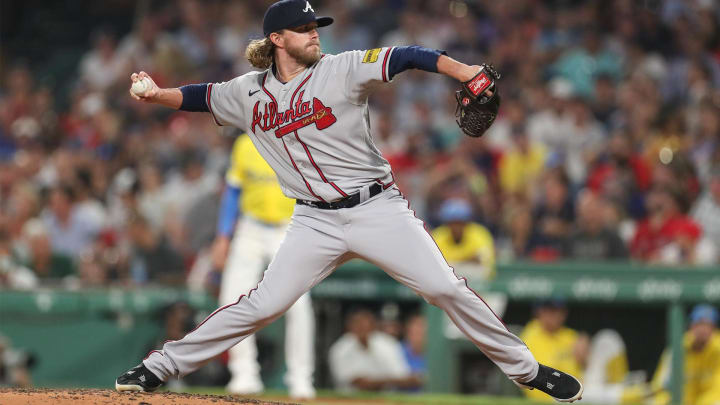Pierce Johnson Has Changed for the Better Since Joining the Braves

When Pierce Johnson was traded from the Rockies to the Braves in late July, he sat down for the customary initial meeting with his new team, speaking with the catchers, pitching coaches, analytics staff and more. They got to know one another a bit and went over some basic game-planning material. And, oh, just one more thing. How’d he feel about a potential change of identity?
“I didn’t know I was a ground-ball guy until I got here,” Johnson says with a laugh.
The statistics back that up. Johnson’s ground-ball rate this season with Colorado was just 28%. But in 21 innings so far with Atlanta? It’s more than doubled to 60%, which is one of the contributing factors to another major change in his stat line: A 6.00 ERA with the Rockies has become a 0.86 with the Braves.
There are plenty of caveats to note there. The sample size is limited, his peripheral numbers aren’t quite as pristine and it’s hard to find a pitcher who doesn’t experience a boost after leaving the hitters’ haven of Coors Field. (Though it was personally a bit more difficult for Johnson, 32, who was born and raised in Colorado.) But the degree of the shift here is still notable. As the Braves prepare to make a deep run in October, boasting the best record in baseball, there’s renewed emphasis on every last member of the roster. And Johnson has gone from a reclamation project to a surprisingly effective piece of the bullpen.
Johnson has long been a popular breakout pick: A first-round selection by the Cubs in 2012, he’s routinely shown flashes of promise, though none has ever quite proved sustainable long term. (That includes a fantastic season with the Hanshin Tigers in Japan in ’19 that he parlayed into an up-and-down, three-year stint with the Padres.) But Johnson never experienced a month of run prevention as good as his August with the Braves.
He says there have been no mechanical changes here. The message from Atlanta’s staff was more straightforward: “Just getting down to basics and sticking to my strengths and going out with a really good game plan from the coaches and the catchers,” he says. That means being more willing to pitch to contact (see: that ground-ball rate), which he credits for a sizable decrease in his walks. (His 5.8 BB/9 in Colorado has dropped to 2.1 in Atlanta.) That mindset has helped him get ahead early in the count, too: His first-pitch strike percentage has gone from 59% before the trade to 73% afterward.
“He’s been doing a tremendous job of attacking,” says Braves catcher Travis d’Arnaud. “Getting strike one, getting strike two and not falling behind too many times.”
His calling card has always been his curveball. As part of playing to his strengths, Atlanta’s game plan for Johnson has been to rely on it even more, and he now throws it about 70% of the time.
“He goes out there and he throws 14 in a row, and they still can’t hit it,” says fellow Braves reliever Brad Hand, who also began the year in Colorado before getting to Atlanta. “They’ll still swing at the ones in the dirt. It’s a really good pitch, and it also helps out his heater a lot.”
Pierce Johnson, 4 Consecutive Ks. 🔨 pic.twitter.com/Lies7MMucg
— Rob Friedman (@PitchingNinja) September 12, 2023
There’s also been more emphasis on how it tunnels with his fastball—which has improved results for both pitches.
“When his body and his arm looks like he’s about to throw 95 [mph], and then that devastating breaking ball comes out, it makes it really hard to hit,” d’Arnaud says.
So: What’s the key, then? The journey to self-discovery as a ground-ball guy? The increased reliance on the curve? The change of scenery?
“The truth is,” Johnson says, “everything’s just kind of fallen into place here.”
